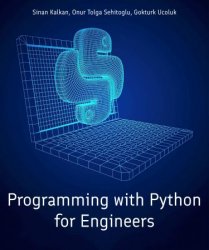Programming with Python for Engineers
- Добавил: literator
- Дата: 26-11-2023, 14:57
- Комментариев: 0
 Название: Programming with Python for Engineers
Название: Programming with Python for EngineersАвтор: Sinan Kalkan, Onur Tolga Sehitoglu, Gokturk Ucoluk
Издательство: Independently published
Год: Nov 09, 2022
Страниц: 259
Язык: английский
Формат: pdf (true)
Размер: 10.1 MB
An interactive book introducing Python to engineers and engineering students.
This book is intended to be an accompanying textbook for teaching programming to science and engineering students with no prior programming expertise. This endeavour requires a delicate balance between providing details on computers & programming in a complete manner and the programming needs of science and engineering disciplines. With the hopes of providing a suitable balance, the book uses Python as the programming language, since it is easy to learn and program. Moreover, for keeping the balance, the book is formed of three parts:
• Part I: The Basics of Computers and Computing: The book starts with what computation is, introduces both the present-day hardware and software infrastructure on which programming is performed and introduces the spectrum of programming languages.
• Part II: Programming with Python: The second part starts with the basic building blocks of Python programming and continues with providing the ground formation for solving a problem in to Python. Since almost all science and engineering libraries in Python are written with an object-oriented approach, a gentle introduction to this concept is also provided in this part.
• Part III: Using Python for Science and Engineering Problems: The last part of the book is dedicated to practical and powerful tools that are widely used by various science and engineering disciplines. These tools provide functionalities for reading and writing data from/to files, working with data (using e.g. algebraic, numerical or statistical computations) and plotting data. These tools are then utilized in example problems and applications at the end of the book.
This is an ‘interactive’ book with a rather ‘minimalist’ approach: Some details or specialized subjects are not emphasized and instead, direct interaction with examples and problems are encouraged. Therefore, rather than being a ‘complete reference manual’, this book is a ‘first things first’ and ‘hands on’ book. The pointers to skipped details will be provided by links in the book. Bearing this in mind, the reader is strongly encouraged to read and interact all contents of the book thoroughly.
The book’s interactivity is thanks to Jupyter notebook. Therefore, the book differs from a conventional book by providing some dynamic content. This content can appear in audio-visual form as well as some applets (small applications) embedded in the book. It is also possible that the book asks the the reader to complete/write a piece of Python program, run it, and inspect the result, from time to time. The reader is encouraged to complete these minor tasks. Such tasks and interactions are of great assistance in gaining acquaintance with Python and building up a self-confidence in solving problems with Python.
Скачать Programming with Python for Engineers
Внимание
Уважаемый посетитель, Вы зашли на сайт как незарегистрированный пользователь.
Мы рекомендуем Вам зарегистрироваться либо войти на сайт под своим именем.
Уважаемый посетитель, Вы зашли на сайт как незарегистрированный пользователь.
Мы рекомендуем Вам зарегистрироваться либо войти на сайт под своим именем.
Информация
Посетители, находящиеся в группе Гости, не могут оставлять комментарии к данной публикации.
Посетители, находящиеся в группе Гости, не могут оставлять комментарии к данной публикации.
